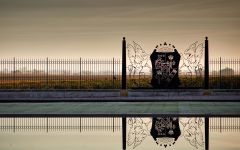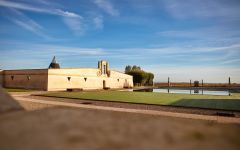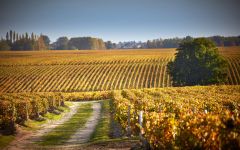Chateau Pichon-Longueville Baron Les Tourelles de Longueville 2019
-
James
Suckling -
Robert
Parker -
Jeb
Dunnuck -
Wine
Spectator




Product Details
Your Rating
Somm Note
Winemaker Notes
Named after the turrets that embellish the château, our wine Les Tourelles de Longueville, embodies the charm of the estate.The grapes that are used to blend the wine come essentially from the Sainte Anne plot, planted mainly to Merlot, giving to it a distinctive personality. Les Tourelles de Longueville is an invitation to enter a world of flavour, charm, roundness and sensual delight.This wine provides an introduction to the spirit of Pichon Baron and can be enjoyed young or aged in the cellar for 15 years or more.
Blend: 68% Merlot, 19% Cabernet Sauvignon, 8% Cabernet Franc, 5% Petit Verdot
The Barrel Sample for this wine is above 14% ABV.
Professional Ratings
-
James Suckling
A red with smoke, blackcurrant and graphite aromas and flavors. It’s full-bodied with firm, chewy tannins and a flavorful finish. Hints of seaweed and wet earth. Barrel Sample: 94-95
-
Robert Parker's Wine Advocate
The 2019 Les Tourelles de Longueville is a blend of 19% Cabernet Sauvignon, 68% Merlot, 8% Cabernet Franc and 5% Petit Verdot, harvested from the 18th of September to the 11th of October. It is being aged in French oak barrels, 30% new, for 12 months. The production of this wine represents 28% of the harvest. Very deep purple-black colored, it features captivatingly pure crushed black plums and fresh blackberry scents on the nose with suggestions of tilled soil, pencil lead, licorice and charcoal with a waft of bay leaves. The full-bodied palate delivers mouth-coating black fruits with a wonderfully plush texture and just enough freshness in the background, finishing long and earthy.
Barrel Sample: 91-93 -
Jeb Dunnuck
Another second wine from this great estate is the 2019 Les Tourelles De Longueville, a Merlot-dominated blend that includes 19% Cabernet Sauvignon, 8% Cabernet Franc, and a splash of Petit Verdot. It's another beautiful, round, sexy 2019 and offers ample ripe black cherries, smoked earth, tobacco, and chocolaty nuances. Medium to full-bodied, round, and lush, with sweet tannins, it's going to put a smile on your face any time over the coming 15 years. Best After 2022
-
Wine Spectator
Shows the rich, warm fruit profile of the vintage, with a nice, slow gush of plum sauce and steeped black currant as well as hints of anise, licorice root and singed cedar. Steady, focused finish. Cabernet Sauvignon, Merlot, Cabernet Franc and Petit Verdot. Best from 2023.
Other Vintages
2022-
James
Suckling -
Jeb
Dunnuck - Decanter
-
James
Suckling -
Jeb
Dunnuck
-
James
Suckling -
Jeb
Dunnuck - Vinous
-
Wine
Enthusiast - Decanter
-
Wine
Spectator -
Robert
Parker
-
James
Suckling -
Wine
Enthusiast - Decanter
-
Robert
Parker
-
James
Suckling -
Jeb
Dunnuck -
Robert
Parker -
Wine
Spectator
-
Wine
Enthusiast -
Wine
Spectator
-
Wine
Enthusiast -
Wine
Spectator
-
Wine
Enthusiast -
James
Suckling -
Wine
Spectator
-
Wine
Spectator







The Estate was founded in the late 17th Century. This period was known as the Grand Siecle, or "great century", in reference to Louis XIV's 1661 accession to the French throne. In 1689 Pierre Desmezures de Rauzan, an influential wine merchant and steward of the prestigious Latour and and Margaux estates, bought plots of vines close to the Latour estate to create Enclos Rauzan. These vines were part of his daughter Therese's dowry when she married Baron Jacques Pichon de Longueville in 1694, the year in which the Pichon Baron estate was founded. An illustrious estate, with an enduring reputation, was born. It remained in the same family for generations.
In 1850 the property was divided in two. Baron Raoul Pichon de Longueville's section became the Pichon Baron estate. The second section, belonging to his three sisters, became Pichon Comtesse. Baron Raoul was proud of his prestigious property, and in 1851 he commissioned the imposing chateau inspired by Renaissance architecture that we know today. This uniquely charming and romantic chateau, with its two emblematic turrets, has stood proudly at the vineyard's heart ever since. During the Universal Exhibition of 1855, the wine was classed as a Second Grand Cru Classe according to the ranking system requested by Emperor Napoleon III, who wished to showcase Bordeaux's great wines. In 1933, the Pichon de Longueville family sold the property to the Bouteiller family, who managed the chateau for over 50 years.
In 1987 the estate was bought by AXA Millesimes, whose aim is to enable great wines from the vineyards with a glorious past to achieve their full potential. An architectural competition was launched in collaboration with the Paris Pompidou Centre to provide the estate with new operational buildings. The comprehensive reconstruction of the fermenting room and cellar, and renovation of the chateau, began in 1988. Since then, the 19th century chateau's image has been
reflected in an ornamental pool stretching majestically before it.. And since 2008, its silvery expanse conceals an underground cellar, reminiscent of Jules Verne's Nautilus, with view of both the water and sky. The barrel cellar complements a production process in which excellence is paramount, in the finest tradition of great Pauillac wines.

One of the world’s most classic and popular styles of red wine, Bordeaux-inspired blends have spread from their homeland in France to nearly every corner of the New World. Typically based on either Cabernet Sauvignon or Merlot and supported by Cabernet Franc, Malbec and Petit Verdot, the best of these are densely hued, fragrant, full of fruit and boast a structure that begs for cellar time. Somm Secret—Blends from Bordeaux are generally earthier compared to those from the New World, which tend to be fruit-dominant.

The leader on the Left Bank in number of first growth classified producers within its boundaries, Pauillac has more than any of the other appellations, at three of the five. Chateau Lafite Rothschild and Mouton Rothschild border St. Estephe on its northern end and Chateau Latour is at Pauillac’s southern end, bordering St. Julien.
While the first growths are certainly some of the better producers of the Left Bank, today they often compete with some of the “lower ranked” producers (second, third, fourth, fifth growth) in quality and value. The Left Bank of Bordeaux subscribes to an arguably outdated method of classification that goes back to 1855. The finest chateaux in that year were judged on the basis of reputation and trading price; changes in rank since then have been miniscule at best. Today producers such as Chateau Pontet-Canet, Chateau Grand Puy-Lacoste, Chateau Lynch-Bages, among others (all fifth growth) offer some of the most outstanding wines in all of Bordeaux.
Defining characteristics of fine wines from Pauillac (i.e. Cabernet-based Bordeaux Blends) include inky and juicy blackcurrant, cedar or cigar box and plush or chalky tannins.
Layers of gravel in the Pauillac region are key to its wines’ character and quality. The layers offer excellent drainage in the relatively flat topography of the region allowing water to run off into “jalles” or streams, which subsequently flow off into the Gironde.
